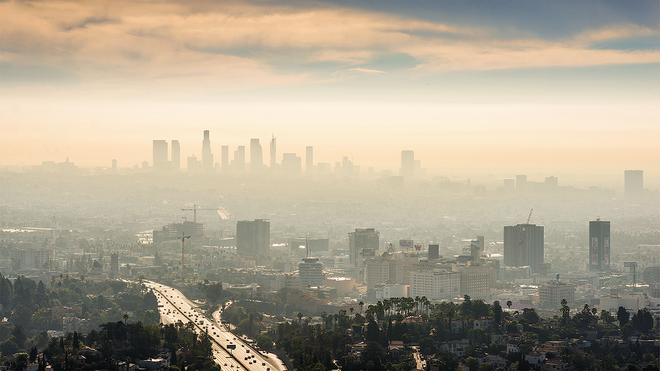Want a quick climate action project? Do more with your streetlights.

Cities have an important role to play in reducing the effects of climate change. Streetlights present a high-impact opportunity for a quick climate action project, with benefits that go far beyond cutting energy consumption.
Cities are resource-intensive hubs of commercial and industrial activity with big populations and complex infrastructure. Streetlights account for approximately 5-10% of a larger city’s annual operating budget and up to 40% of their total electricity budget. They present a good opportunity to reduce emissions. Ubicquia conducted a study for a city with 508,000 with an aggressive climate action plan and found that smarter street lighting strategies could reduce their carbon dioxide emissions by 1,129,000 metric tons by 2040 and move them four percentage points closer to their emission targets.
That alone is a good reason for cities to initiate climate action projects, but the drivers don’t stop there. Most municipalities are under pressure to maintain infrastructure and deliver services. They need a first step that delivers results without complexity. Since street lighting consumes up to 40% of municipal electricity budgets, they are a good place to start. Just switching from traditional high-pressure sodium (HPS) technology to LED can cut lighting-related power consumption in half. But that’s only the beginning of the savings.
Switching from HPS technology to LED can cut lighting-related power consumption in half. But that’s only the beginning of the savings.
Smart lighting technology gives cities control over how much light they use
Adding lighting controls to LED streetlamps boosts potential energy savings by as much as another 25%. (See our recent blog on the ROI of lighting controls for more details.) Across a citywide streetlight infrastructure, the ability to dim individual luminaires to suit location-specific lighting needs reduces not only overall energy use but also associated CO2 emissions.
Dimming can be done proactively on a scheduled basis or automatically using photocell measurements that adjust light intensity according to ambient light in the environment. San Jose, in the heart of Silicon Valley, replaced its 62,000 streetlights with smart, energy-efficient LED lighting. Before starting, they conducted a lighting assessment. They studied vehicle and pedestrian volume on streets at various times during the night, and determined they could dim lighting by 50% without impacting safety. This streetlight conversion project has allowed San Jose to save approximately 40% energy savings.
Along with the energy savings, dimming allows cities to reduce light pollution. Research has shown that insects, animals, and even human sleep cycles are affected by urban light pollution. Dimming streetlights helps reduce those impacts. Pepperell, Massachusetts is a dark sky community with dimmable street lighting deployed by Ubicquia and partner RealTerm Energy.
The Village of Nyack is another community that opted to convert their streetlights to LED and add lighting controls. Nyack saves an estimated 272,268 kilowatt-hours of energy per year, equivalent to a 68% reduction. Their LEDs also improve Nyack’s environmental footprint by reducing greenhouse gas emissions by an estimated 193 metric tons of greenhouse gas annually, equivalent to the gas emissions from approximately 41 passenger vehicles driven for one year. They chose lighting that eliminates the “orange sky glow” found over many cities. They also ensured their LED fixtures were “Dark Sky Compliant”. In recognition of the positive impact of their project, Nyack received a grant award from NYSERDA.
Adding lighting controls to LED streetlamps boosts the potential energy savings by as much as another 25%.
Climate action project benefits beyond lighting alone
Lighting and electricity use are of course not the only sources of GHG emissions in urban environments. Vehicle traffic is a significant source that streetlights can also help address by hosting video AI traffic management applications that can reduce congestion by a third, according to a recent report by Juniper.
Air quality is a broader concern for many communities, since it can have immediate health impacts, especially on vulnerable people such as young children and the elderly. Here again, streetlights can help. They can host air quality monitoring (AQM) sensors to track levels of carbon monoxide, nitrogen dioxide, sulfur dioxide, ozone, and particulate matter such as smoke.
Las Vegas, Nevada, is using the Ubicquia AQM sensor to monitor its air quality index (AQI). They are using the sensors on streetlights to register temperature, humidity, and even street-level noise. This gives them deeper real-time insights into a whole range of variables that affect the citizen experience, the natural environment and long-term sustainability.
Seizing the moment for your climate action project
Because many communities have tight budgets to begin with, they need funding to deploy smart streetlight technologies that can support all these various applications. The American Rescue Plan Act, the Inflation Reduction Act and the Infrastructure and Jobs Act have made billions of dollars available for technology and climate action projects.
Municipalities must apply. Awards are competitive: communities must clearly articulate the expected benefits of their initiatives. Doing the analysis today, firming up the business case and factoring in the full picture of LED lighting controls, traffic optimization, and environmental sensors will put a town or city ahead of the pack when it comes time to apply for funding. And since it’s likely that, down the road, environmental and energy-saving measures are going to become mandatory, communities that invest today will be ready for compliance tomorrow — and start reaping the cost and energy-conserving benefits sooner from their climate action projects.

